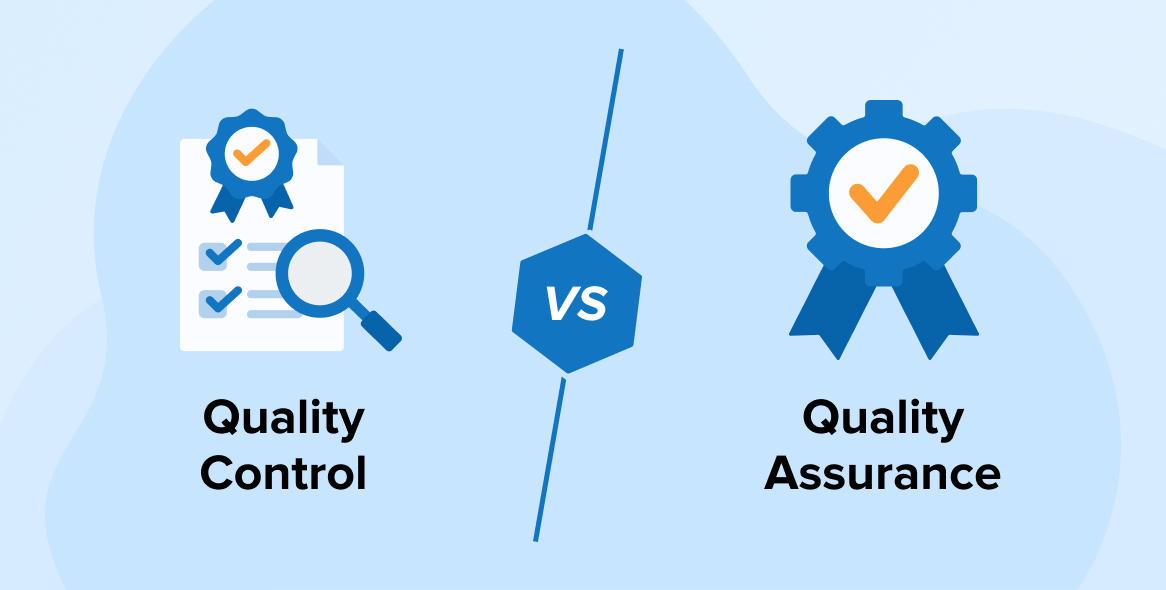
Many people still believe that QA and software testing are separate processes, even though they share the same methodology. Software testing involves checking a product or service to see if it functions as intended and meets user requirements. Whereas, “quality assurance” is a broader term for the whole process of ensuring that a product or service works as planned and serves the user’s requirements.
Let’s bust some myths about what software testing and quality assurance are, how they differ, and how a software testing company can help ensure everyone is on the same page.
1. Software Testing Overview
Software testing is the process of examining a system for flaws and issues, as well as verifying the functionality of the code provided by developers. Various techniques are applied to assess the product, identify faults, and determine if they have been corrected. In terms of design, usability, and functionality, testing allows us to determine if a generated product meets client requirements and objectives.
In essence, it is a collection of procedures to ensure that the latest version of the product generates outcomes that closely align with the acceptance criteria and other specifications. One of the greatest benefits of testing in IT projects is the generation of error reports that are easy to understand. This allows, engineers to comprehend what went wrong and how to correct it. Notably, testing can only identify vulnerabilities and flaws in an existing product or limited portions of it.
Different procedures and methodologies are used to perform tests that are either run manually or fully automated. Adopting the right approach, you can perform tests at every stage of the development cycle to check the software’s static and dynamic aspects.
There are many testing methods, such as testing in production, user acceptance testing, system testing, integration testing, performance testing, functional testing, unit testing, beta testing, etc. Simply said, testing is intended to prevent issues with the product from reaching clients after its appropriate delivery.
Here is what Twitter user says about software testing.
Software Testing – :
— THE CODE SCIENTIST (@mysticwillz) August 28, 2024
Software testing is like checking a product for defects before it hits the market.
it’s the process of evaluating a program to ensure it
works as expected,
is free of bugs, and
meets the user’s needs.
We can test our frontend in the following ways…
1.1 Advantages of Software Testing
Here are the advantages of software testing.
1. Enhances Quality
Software testing identifies bugs in software so they can be fixed before the product is released to the public. This improves the quality of the software which helps deliver better user experience. Cost Savings
It is less expensive to find and fix bugs early on in the development process than to address them during production, where they cause more problems and incur higher costs.
2. Early Detection of Issues
Performing well-planned tests at the beginning and throughout the production process helps find bugs. This allows you to solve the problems quickly, reducing the chance that important mistakes will reach the production stage. Early discovery also makes it easier for coders, testers, and stakeholders to work together to solve problems quickly.
3. Enhanced Security
In the digital age, security is the most important thing, and customers prioritize the safety of systems above all else. For this reason, owners invest significant resources in protecting their systems from hackers, cyber crimes, and other forms of theft. Security testing is a method used to assess the security of an application. Testers identify vulnerabilities in the app’s security that can be used to break it.
1.2 Disadvantages of Software Testing
Here are the disadvantages of software testing:
1. Time
It may take a long time to complete software testing. It could take days or weeks, based on how difficult the application is and the number of tests that need to be conducted.
2. Costly
Tools, methods, and quality assurance professionals can be expensive, particularly for large projects. Financial constraints restrict your efforts in the research arena.
3. Testing Tools Complexity
You need specific expertise to use automatic testing tools. Their setup and maintenance are also very difficult.
1.3 Types of Software Testing
There are various types of software testing and each has a different purpose. Let’s discuss a few widely used tests in this section.
1. Performance Testing
As the name suggests, this type of testing is carried out to evaluate the performance in terms of responsiveness and stability under the workload. It helps analyze an application’s reliability, size, speed, and robustness.
2. Acceptance Testing
This type of software testing verifies whether the entire system works as expected and checks if all the business requirements are fulfilled. There are various types of acceptance testing such as alpha testing, user acceptance testing, beta testing, and business acceptance testing.
3. Unit Testing
This software testing technique checks all the components of the system to validate whether each software unit is performing as per expectation or not. It is performed by a team of software developers during the early phases of application development.
4. Regression Testing
This software testing method tests existing software applications to make sure that a new addition or change in the software is not affecting the existing functionality of the system. It is a partial or full selection of executed test cases that are performed to check whether the existing functionalities are working fine.
5. Functional Testing
This software testing technique is commonly used by QA professionals to verify whether a specific part of the software is working according to the predetermined requirements. The testing process is based on the specifications of the software component being tested.
6. Integration Testing
This software testing phase tests software modules as a group and checks the system’s compliance with the predetermined functional requirements. Integration testing is conducted after unit testing and focuses on identifying defects in the interaction between integrated units.
7. Sanity Testing
This quick evaluation checks whether the assembled material is rational. The sanity testing technique helps rule out classes of obviously incorrect outcomes rather than identifying every possible error.
2. Quality Assurance Overview
When you uphold the predetermined quality standards for your project, you reduce the chances of making mistakes that might compromise its success.
This aspect of quality management ensures that the promised characteristics of a product or service are consistently delivered, contributing to the achievement of a company’s quality objectives. The goal here is to streamline the software development process while making it easier to detect bugs.
Successful IT solutions rely heavily on software quality assurance (QA) since it addresses many management concerns, such as development approaches, project analysis, and protocols. A well-thought-out assessment method makes development more efficient and helps reach long-term objectives.
Careful execution of a proper QA strategy throughout the product development process allows you to meet the required quality standards. The project’s progress and each QA team member’s contributions are accurately recorded. The QA group collects and examines the statistics from the entire software development lifecycle to adjust their approach. Having access to such data has proven useful in identifying product-wide issues among analysts and engineers.
A significant number of regression errors, along with minor adjustments that may require more financial resources and a delivery date that is delayed over the target range, are all theoretical risks that might occur at any point. It’s reasonable to assume that QA work influences every stage of product development, from initial concept to final testing and deployment. In an ideal scenario, QA would streamline operations and modify procedures to eliminate the need for fixing bugs. In actual use, it significantly reduces the issues. Sharing the responsibility of adhering to QA guidelines throughout the team is a valuable endeavor.
2.1 Advantages of Quality Assurance
Here are the advantages of quality assurance.
2.1.1 Improves Reliability
Quality assurance aims to ensure that the software meets the needs of the user, which makes the software more reliable. This process helps verify that the software functions correctly and effectively.
2.1.2 Prevention of Defects
Organizations can avoid errors and flaws by implementing quality assurance measures. This reduces the need for extensive testing and rework.
2.1.3 Increasing Customer Satisfaction
Customer satisfaction increases when you consistently provide high-quality services or products that meet or exceed expectations. Happy customers are more likely to remain loyal, give good feedback, and tell others about the service. This improves the brand’s image and keeps customers coming back.
2.1.4 Better User Experience
The QA team carefully considers how customers feel about the product. Meeting customer standards and providing a great experience are two main goals of quality assurance. This involves not only ensuring that the software is free of bugs and runs smoothly; it also includes a website’s appearance, speed, usefulness, and ease of access. A relevant customer journey is important for a business’s growth.
2.2 Disadvantages of Quality Assurance
Here are the disadvantages of quality assurance.
2.2.1 Time-Consuming
Doing everything in QA will take time, and in some cases, this time is consumed by meetings and paperwork instead of working on software development and testing.
2.2.2 Higher Costs
Appropriate testing instruments and highly qualified experts cost more, but this investment is covered by higher-end quality.
2.2.3 Human Error
Human error is unavoidable, even in quality assurance. If a tester makes an error during the quality assurance process, it might result in expensive mistakes that are hard to correct.
2.2.4 Process Limitation
Testing software is an ongoing process that requires significant time and effort. Choosing the appropriate test scenarios can also be challenging.
2.3 Types of Quality Assurance Testing
Quality assurance (QA) is a process-oriented strategy for making sure software is effective. Here are some of the most common types to consider as a part of the quality assurance process.
2.3.1 Unit Testing
Unit testing is a type of testing performed at the ground level to test individual units of the software under development. Developers focus on testing during the development phase to ensure that each unit of the app’s code meets the required standards.
2.3.2 Component Testing
Once you’re done with unit testing, component testing is performed as it allows software testers to test more than one unit or component in a single code. It uses real data and tests how different components work without being dependent on integration. Component testing helps to identify defects that may arise, once the components are connected.
2.3.3 End-to-End Testing
End-to-end testing is a type of QA testing that helps in testing the performance and functionality of the system in live settings. It also helps simulate real-world scenarios and test data integrity and intercommunication with other systems.
2.3.4 Smoke Testing
It involves reviewing whether the basic functionality of the application is working as expected. This process is especially useful after a new build, as it helps determine if more expensive tests need to be conducted on the application in the newly deployed environment.
2.3.5 System Testing
System testing allows QA teams to consider how various components of software interact within a fully, integrated system. It focuses on overall requirement specifications and ensures that every type of user input produces the intended output.
2.3.6 User Acceptance Testing
This is the last test performed in the QA lifecycle before the final release. It assesses if the application can handle real-world scenarios.
3. How Does Software Testing Differ From Quality Assurance?
Though they have distinct goals, approaches, and priorities, they both contribute significantly to guaranteeing the delivery of high-quality software. Software testing and quality assurance differ mostly in these ways:
| Key Difference | Software Testing | Quality Assurance |
|---|---|---|
| Definition | Software testing is the process of executing a program or system to identify defects or errors. | Quality Assurance (QA) is the process of ensuring that the software product meets the specified quality standards. |
| Timing | Usually, testing comes following the development of the program. It’s a validation method meant to verify whether the software satisfies the given criteria. | Quality assurance begins at the start of the entire software development process and continues throughout its lifecycle. It covers tasks including training, standards enforcement, and process audits meant to help the development process itself. |
| Focus | Focuses on ensuring the system satisfies certain criteria and spotting errors and shortcomings. | Emphasizes enhancing and streamlining the steps of the software development life cycle. |
| Technique | Among the several methods used in software testing are unit testing, functional testing, integration testing, system testing, etc. | Quality assurance calls for methods like process audits, defect management, root cause analysis, etc. |
| Cost | Usually, software testing costs more than quality assurance costs. | Quality assurance is less expensive than software testing. |
| Time Span | Short-term objectives, including identifying and fixing flaws in the present software release, take first place in testing. | Aiming to enhance procedures and prevent flaws in the next software projects, quality assurance has a long-term perspective. |
| Outcome | Guarantees that the application runs as intended and is bug-free. | Guarantees that the finest practices and standards are followed throughout the software development life cycle. |
| Tools Used | Makes use of technologies meant for test automation, bug tracking, and test case management. | Uses tools for process documentation, project management, and process monitoring. |
4. Conclusion
Firstly, in the previous several decades, test automation and initiatives like shift-left testing have blurred the distinctions between testing and quality assurance. The emergence of continuous integration/continuous delivery (CI/CD) and the DevOps ethos, has shattered internal silos, erasing the differences between the development, testing, and operations teams. Testing has always been a crucial element of quality assurance. Therefore, testing procedures must be included as part of quality assurance (QA), which is defined as a set of measures taken by a team to ensure that the final product meets or exceeds expectations.






Comments
Leave a message...